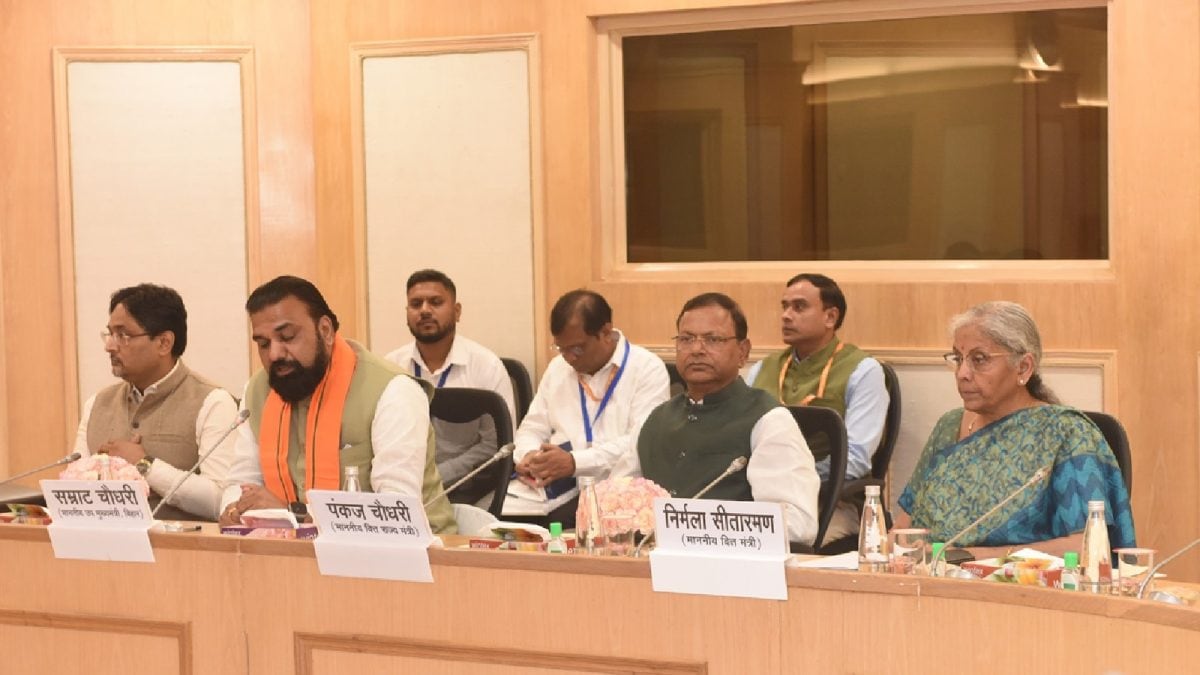Last Updated:
The finance minister presents to GoMs from states the Centre’s blueprint for the next generation of GST reforms, describing it as a step towards making India Aatmanirbhar.

Union Finance Minister Nirmala Sitharaman on Wednesday addresses the Group of Ministers (GoMs) constituted by the GST Council on Compensation Cess, Health & Life Insurance, and Rate Rationalisation at Vigyan Bhawan, New Delhi.
Finance Minister Nirmala Sitharaman on Wednesday said the GST rate rationalisation, which may reportedly include reducing the GST structure to two slabs of 5% and 18%, will provide relief to common man, farmers, the middle class and MSMEs, while ensuring a simplified, transparent and growth-oriented tax regime.
“This would enhance affordability, boost consumption and make essential and aspirational goods more accessible to a wider population,” Sitharaman said, according to a post by the finance ministry on X.
Union Minister for Finance and Corporate Affairs Smt. @nsitharaman today addressed the Group of Ministers (GoMs) constituted by the GST Council on Compensation Cess, Health & Life Insurance, and Rate Rationalisation at Vigyan Bhawan, New Delhi. Union Minister of State for… pic.twitter.com/hMRFOCwXBF— Ministry of Finance (@FinMinIndia) August 20, 2025
The finance minister said this during a meeting of the Group of Ministers (GoMs) constituted by the GST Council on Compensation Cess, Health & Life Insurance, and Rate Rationalisation, at Vigyan Bhawan, New Delhi.
Sitharaman also said the new GST regime will make people self-sufficient and boost growth in manufacturing and MSMEs.
The Union finance minister also presented to GoMs from states the Centre’s blueprint for the next generation of goods and services tax (GST) reforms, describing it as a step towards making India Aatmanirbhar while committing to build consensus with states in the coming weeks.
Speaking to Groups of Ministers (GoMs) on rate rationalisation, insurance taxation, and compensation cess, Sitharaman said “emphasised that the proposal by the Central Government is with a vision to usher in the next generation of GST reforms in India’s journey towards becoming #AtmanirbharBharat.”
“During the meeting, the Union Finance Minister emphasised that the proposal by the Central Government is with a vision to usher in the next generation of GST reforms in India’s journey towards becoming Atmanirbhar Bharat,” Sitharaman said during the meeting.
According to a PTI report citing a source present at the meeting, the Union finance minister’s address lasted about 20 minutes, during which she explained the rationale for reforms and urged states to support the transition. The rate rationalisation GoM is scheduled to meet again on August 21.
Two-Slab GST Structure
The three GoMs will over two days deliberate on the Centre’s ‘next-gen’ GST reforms under which tax will be levied at 5 and 18 per cent rates. A special 40 per cent rate has been proposed on 5-7 items, including sin goods. Currently, GST is levied at 5%, 12%, 18% and 28%, with luxury and demerit goods in the highest bracket and many food and essential items either exempt or taxed at 5%.
At the GoM meeting, finance minister said, “The next-generation GST stands on three pillars: structural reforms, rate rationalisation, and ease of living.”
Exemption for Insurance Premiums For Individuals
Bihar Deputy CM Samrat Choudhary, who is also the convenor of insurance GoM, said the Centre has proposed exempting health and life insurance premiums from GST for individuals, to which some states differed. Currently, such premiums attract 18% GST.
“The Centre’s proposal is clear that the insurance sector’s individual and family (policies) should be exempt from GST. This has been discussed and the GoM report will be presented to the Council,” Choudhary told reporters.
The panel, comprising ministers from 13 states including Uttar Pradesh, West Bengal, Karnataka, Kerala and Tamil Nadu, will submit its report to the GST Council by October-end.
Union Minister of State for Finance, Chief Minister of Goa, Deputy CM of Bihar and Finance Ministers of States in the three GoMs were also present at the meeting.
Fiscal Impact and Next Steps
According to an SBI Research estimate, the proposed changes could lead to a revenue loss of about Rs 85,000 crore annually, and about Rs 45,000 crore in the current fiscal if implemented from October 1. The research note said the effective weighted average GST rate has already fallen from 14.4% at inception to 11.6% in 2019, and may drop further to 9.5% post-reforms.
The GoM on compensation cess is also deliberating on the levy’s future after repayment of loans taken to compensate states during the pandemic.
Once the GoM reports are finalised, the proposals will be placed before the GST Council, which includes representatives from the Centre and all states.
Prime Minister Narendra Modi in his 79th Independence Speech last week announced that the rollout of the GST reforms is targeted by Diwali 2025.

Haris is Deputy News Editor (Business) at news18.com. He writes on various issues related to personal finance, markets, economy and companies. Having over a decade of experience in financial journalism, Haris h…Read More
Haris is Deputy News Editor (Business) at news18.com. He writes on various issues related to personal finance, markets, economy and companies. Having over a decade of experience in financial journalism, Haris h… Read More
Read More








